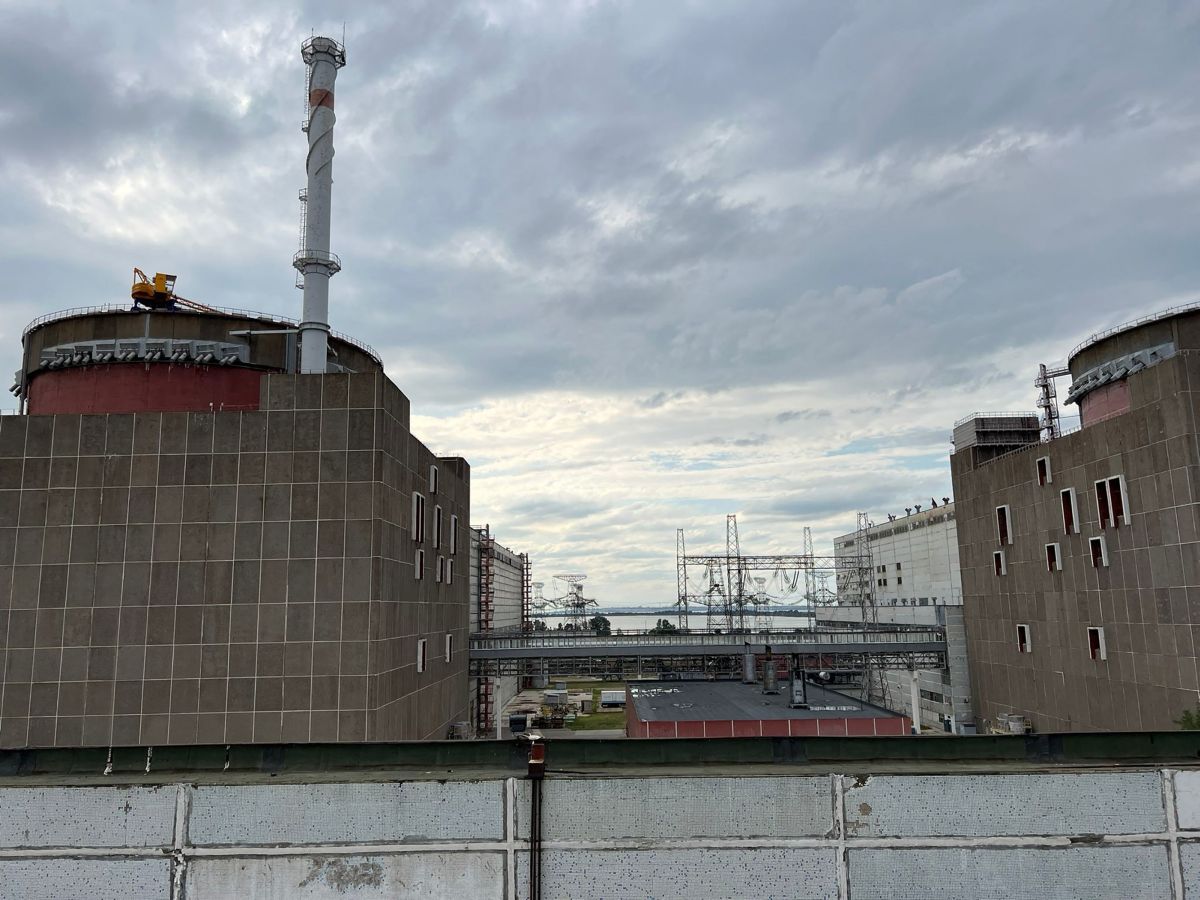Russia Attempts Blackmail with Occupation of the Zaporizhzhia Nuclear Power Plant
Russia is trying to use the fear of a nuclear disaster at the Enerhodar power plant to reduce the scale of Western support for Ukraine and force it to accept unfavourable conditions for a possible ceasefire. The international community should adopt a two-track approach to counter this attempt. On the one hand, efforts should be made to increase the safety of the power plant by establishing a “safety and security protection zone” around it and, on the other hand, coordinate information activities to clearly indicate that Russia is solely responsible for the risk of nuclear catastrophe.
 ABACA/Abaca Press/Forum
ABACA/Abaca Press/Forum
Since the invasion of Ukraine in February this year, Russia has been attacking Ukrainian essential energy infrastructure, which supports its security and economy. Nearly 40% of installations supplying electricity in Ukraine have been occupied or destroyed, mainly in the east and south of the country. The attacks have hit around 350 facilities, including power plants and heating stations, refineries, transmission lines, gas pipelines, compressor stations, and renewable energy installations, with only about half of them successfully restored. The Russians occupy, among others, the nuclear power plant in Enerhodar (ZNPP), located in the Zaporizhzhia oblast, which is under partial Russian control. After the announcement of the illegal annexation of four eastern regions of Ukraine, including Zaporizhzhia, Vladimir Putin declared that the power plant would become the property of Russia. Both states are accusing each other of conducting shelling that threatens the security of the ZNPP. In addition, Ukraine accuses Russia of keeping military heavy equipment on the site that is used to attack Ukrainian troops.
Nuclear Incident Risk
The Zaporizhzhia nuclear power plant consists of six reactors with a capacity of 950 MW each. Before the Russian invasion, it covered 25% of Ukraine’s electricity demand. Additional infrastructure is crucial for its functioning, including four high-voltage lines, cooling-water tanks, and a nearby heating and power plant. Although according to international standards, the design of the Zaporizhzhia reactors should withstand even the impact of a passenger aircraft, military operations create a number of threats that can lead to accidents and radioactive contamination. Damage to nuclear fuel and radioactive waste disposal facilities on the power plant site is possible. There is also a risk of a damage to the power system, which is needed to maintain coolant flow through the reactors. When they are damaged, the power plant relies on emergency power provided by diesel generators and fuel reserves for about 10 days. A complete loss of power can potentially lead to a meltdown of the core, permanent damage to the reactor, and release of radioactive substances to the atmosphere, soil, and water. The power lines have been damaged several times already, which has caused the ZNPP to be temporarily cut off from its external power supply, forcing it to use generators.
While the power plant was seized by Russian forces, its Ukrainian staff continues to work, but these experts are treated as hostages and under constant pressure, which increases the risk of mistakes in a crisis. The Russians recently kidnapped the director of the ZNPP and then released him after a few days, but he did not return to work. Since the nuclear plant is formally owned by Ukraine under the control of the state-owned company Enerhoatom, attempts to subordinate it to the Russian company Rosatom and the Russian leadership may lead to a serious dispute over the responsibility for its safety. The risk of failure may also increase when attempts are made to connect the power plant to the Russian power grid.
In the event of an incident related to the release of radioactive substances into the atmosphere, the extent of the contamination would depend on many factors, including weather conditions. Due to wind directions, the most exposed areas to contamination would be the southern regions of Ukraine, including the occupied Crimea, but also Turkey, Greece, Bulgaria, Moldova, and Romania. To reduce the risk of an incident, five reactors have been shut down for most of the time since the Russians entered Enerhodar, and the sixth has operated on a limited basis. Currently, all reactors in the Zaporizhzhia nuclear power plant remain shut down due to the increased fighting related to the Ukrainian counter-offensive and Russian attacks on power lines. According to the International Atomic Energy Agency (IAEA), although there was no immediate military threat to the power plant, all the pillars of nuclear safety determined by the Agency (seven of them altogether), including its physical integrity, maintenance of safety systems, and the reliability of communication, have been undermined during the conflict.
Russian Blackmail
The goal of the Russian attacks on Ukraine’s energy infrastructure is to destabilise the state internally, to weaken Ukraine’s will to defend itself and wage a counter-offensive to recover lost territories. At the same time, Russia is trying to escalate the energy crisis in Europe and uses the threat of a nuclear incident to intimidate international public opinion and discourage at least some countries from supporting Ukraine. The Russian defence ministry has warned, for example, that in the event of an incident at the Zaporizhzhia power plant, the contamination could reach, among others, Slovakia, Poland, and Germany. However, the Russian narrative related to the threat of a catastrophe was accompanied by an effective media counteroffensive by Ukraine that pointed to Russia as the aggressor and solely responsible for a possible incident and its consequences. The risk of such an event also prompted the IAEA to conduct an inspection of the ZNPP in early September. Russia has unsuccessfully tried to use the visit of the inspectors to convince the international community that it is Ukrainian forces that are responsible for the shelling of the facility. Although the IAEA has not determined who is responsible for such actions, it has left two inspectors at the Enerhodar power plant and called for the establishment of a “safety and security protection zone” around the facility. The IAEA Council also called on Russia to leave the site. Even though Russia has accused the agency of operating under “Western influence”, it has found itself under increasing international pressure to ensure the safety of the power plant.
Russia’s attempts to destabilise Ukraine internally by cutting it off from an important energy source have also failed to bring the expected results. The hostilities have led to significant changes on the Ukrainian energy market. The decrease in supply resulting from the destruction or shutdown of energy infrastructure, including the ZNPP, has been accompanied by a decrease in demand by about 40% due to the destruction of thousands of houses and workplaces, mass emigration, and economic collapse.
Conclusions and Perspectives
It is not in the interest of Russia to deliberately provoke a nuclear incident at the Zaporizhzhia power plant since the contamination could extend to territories occupied by Russia, including Crimea. However, as long as the plant is occupied by the Russians and military operations continue in its vicinity, there is an increased risk of a radioactive incident. Therefore, the priority should be to ensure the safety of the power plant, for example, by establishing an UN-supervised protection zone around it. The basic condition should be the withdrawal of Russian troops from the power plant so the international community’s actions do not lead to the consolidation of the Russian occupation. To increase the pressure on the Russian authorities, Ukraine and the states supporting it should strengthen information campaigns pointing to Russia as the aggressor and the one that bears the main responsibility for the safety of the power plant.
Russia is trying to increase pressure on Ukraine by attacking Ukrainian energy infrastructure. Ukrainians, however, can meet their needs with energy from other operating nuclear power plants in southern Ukraine, Rivne and Khmelnytskyi, and hydropower plants, renewable energy and combined heating and power plants, provided that coal and gas supplies are secured.
Despite the Russian threats and blackmail attempts, Ukraine’s partners still support it, but it cannot be ruled out that it may change in the future. Therefore, the Ukrainian authorities should actively undermine Russia’s efforts to use the energy crisis to weaken European public support for Ukraine. Despite the closure of the ZNPP, Ukraine can still export about 600 MW to the EU at favourable prices and plans to support European countries in the energy crisis. In recent months, it has been able to export an oversupply of electricity thanks to interconnections with Romania and Slovakia, and in the future will be able to use connections with Hungary and Poland after the reconstruction of the Rzeszów - Khmelnytskyi connection.



